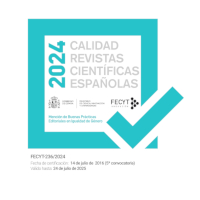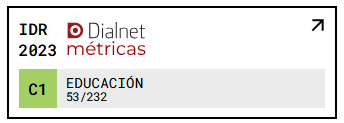Challenges, considerations, and difficulties of the linguistic telematic evaluation during Covid-19
DOI:
https://doi.org/10.18172/con.5057Keywords:
Assessment, online, language delay, languageAbstract
The consequences of COVID-19 have led to a change in the evaluation of children with language difficulties that prompts us to undertake online evaluations. This research aims to analyze the telematic linguistic evaluation, and to determine its challenges and difficulties and detail a series of recommendations to use it. A Case Study is carried out from the qualitative paradigm. Participating 11 children with delayed language or Developmental Disorder of Language (DDL) from 3 years and 4 months to 5 years and 11 months; accompanied by their parents during the online evaluation. For data analysis, the statistical tool Atlas.ti 8 was used. The information gathering technique is the video recording of the evaluation using three standardized tests. As main results we point out that, on occasions, families warn infants that they cannot help them to carry out the assigned task (23), other times families provide clues to the infant about the correct answer (16), difficulties have also arisen external (4) or syllabled repetition by the family (4). In conclusion, we were able to understand the challenges and difficulties of telematic evaluation, but it is necessary to expand the results. In addition, recommendations are proposed to help improve the online assessment situation.
Downloads
References
Acosta, V., Moreno, A. y Axpe, A. (2012). Implicaciones clínicas del diagnóstico diferencial temprano entre Retraso de Lenguaje (RL) y Trastorno Específico del Lenguaje (TEL). Universitas Psychologica, 11(1), 279-291. DOI: https://doi.org/10.11144/Javeriana.upsy11-1.icdd
Aguado, G., Coloma, C., Martínez, A., Mendoza, E. y Montes, A. (2015). Documento de consenso elaborado por el comité de expertos en TEL sobre el diagnóstico. Revista de logopedia, foniatría y audiología, 35(4), 147-149. https://doi.org/10.1016/j.rlfa.2015.06.004 DOI: https://doi.org/10.1016/j.rlfa.2015.06.004
Aguilar-Mediavilla, E., Buil-Legaz, L., López-Penadés, R., Sánchez-Azanza, V. A. y Adrover-Roig, D. (2019). Academic outcomes in bilingual children with developmental language disorder: A longitudinal study. Frontiers in Psychology, 10(531), 1-17. https://doi.org/10.3389/fpsyg.2019.00531 DOI: https://doi.org/10.3389/fpsyg.2019.00531
Aguinaga, G., Armentia, M., Fraile, A., Olangua, P. y Úriz, N. (2005). Prueba de lenguaje oral de Navarra Revisada (PLON)-R. TEA Ediciones.
Auza-Benavides, A. y Murata, C. (2021). ¿Las clases léxicas y gramaticales de los hablantes tardíos podrían predecir a los futuros niños con TEL? Revista de investigación en logopedia, 11, 39-51. https://doi.org/10.5209/rlog.70268 DOI: https://doi.org/10.5209/rlog.70268
Bahamonde, C., Serrat, E. y Vilà, M. (2021). Intervención en Trastorno del Desarrollo del Lenguaje (TDL). Una revisión sistemática (2000-2020). Revista de Investigación en Logopedia, 11, 17-34. https://doi.org/10.5209/rlog.71975 DOI: https://doi.org/10.5209/rlog.71975
Battistin, T., Mercuriali, E., Zanardo, V., Gregori, D., Lorenzoni, G., Nasato, L. y Reffo, M. E. (2020). Distance support and online intervention to blind and visually impaired children during the pandemic COVID-19. Research in Developmental Disabilities, 1-8. DOI: https://doi.org/10.1016/j.ridd.2020.103816
Cáceres-Muñoz, J., Jiménez Hernández, A. S. y Martín-Sánchez, M. (2020). Cierre de Escuelas y Desigualdad Socioeducativa en Tiempos del Covid-19. Una Investigación Exploratoria en Clave Internacional. Revista Internacional de Educación para la Justicia Social, 9(3), 199-221. DOI: https://doi.org/10.15366/riejs2020.9.3.011
Carballo, G. (2012). Guía para la evaluación del TEL: algunas consideraciones. Revista de logopedia, foniatría y audiología, 32(2), 87-93. https://doi.org/10.1016/j.rlfa.2012.03.004 DOI: https://doi.org/10.1016/j.rlfa.2012.03.004
Carballo, G. y Fresneda, M. (2005). Evaluación e Intervención logopédica en el trastorno específico del lenguaje. Revista de Neurología, 41(Supl. 1), S73-S82. DOI: https://doi.org/10.33588/rn.41S01.2005332
Cohen, N. J. (2001). Language impairment and psychopathology in infants, children, and adolescents. Sage. DOI: https://doi.org/10.4135/9781452231808
Cole, C., Martin, V., Moody, J. y Miller, B. (1986). Speech pathology at a distance. Australian Communication Quarterly, 2, 17-19
Dunn, L. M. y Dunn, L. M. (1981). Peabody Picture Vocabulary Test-Revised. AGS.
Dunn, L. M., Dunn, L. y Arribas. (2006). PPVT-III. Test Peabody de Vocabulario en Imágenes. TEA Ediciones.
Ellis, S. (2007). Language development spectrum? En R. Paul (Ed.), Language disorders from a developmental perspective (pp. 83-101). Erlbaum.
Fairweather, C., Parkin, M. y Rozsa, M. (2004). Speech and language assessment in school-aged children via videoconferencing. En B. E. Murdoch, J. Goozee, B. Whelan, y K. Docking (Eds.), Proceedings of the 26th World Congress of the International Association of Logopaedics and Phoniatrics (IALP). Speech Pathology Australia.
Fong, R., Tsai, C. F. y Yiu, O. Y. (2020). The implementation of telepractice in speech language pathology in Hong Kong during the COVID-19 pandemic. Telemedicine and e-Health. DOI: https://doi.org/10.1089/tmj.2020.0223
Galeano, M. E. (2020). Diseño de proyectos en la investigación cualitativa. Universidad Eafit.
García Gómez, T. (2018). Bases del derecho a la educación: La justicia social y la democracia. Revista Internacional de Educación para la Justicia Social, 7(1), 159-175. https://doi.org/10.15366/riejs2018.7.1.008 DOI: https://doi.org/10.15366/riejs2018.7.1.008
Haaf, R., Duncan, B., Skarakis-Doyle, E., Carew, M. y Kapitan, P. (1999). Computer-based language assessment software: The effects of presentation and response format. Language, Speech, and Hearing Services in Schools, 30, 68-74. DOI: https://doi.org/10.1044/0161-1461.3001.68
Lepe-Martínez, N., Pérez-Salas, C. P., Rojas-Barahona, C. A. y Ramos-Galarza, C. (2018). Funciones ejecutivas en niños con trastorno del lenguaje: algunos antecedentes desde la neuropsicología. Avances en psicología latinoamericana, 36(2), 389-403. http://doi.org/10.12804/revistas.urosario.edu.co/apl/a.5609 DOI: https://doi.org/10.12804/revistas.urosario.edu.co/apl/a.5609
Lombardo-Aburto, E. (2020). Detección oportuna del niño con trastorno del lenguaje. Acta Pediátrica de México, 41(5), 231-234. http://doi.org/10.18233/APM41No5pp231-2341999 DOI: https://doi.org/10.18233/APM41No5pp231-2341999
Mendoza, E. (2010). La evaluación del lenguaje: orientaciones alternativas. Revista de Logopedia, Foniatría y Audiología, 30(4), 167-173. https://doi.org/10.1016/S0214-4603(10)70152-2 DOI: https://doi.org/10.1016/S0214-4603(10)70152-2
Mendoza, E. (2016). Trastorno específico del lenguaje (TEL). Avances en el estudio de un trastorno invisible. Pirámide.
Miguélez, B. A. (2016). Investigación social cualitativa y dilemas éticos: de la ética vacía a la ética situada. EMPIRIA. Revista de Metodología de las Ciencias Sociales, 34, 101-119. https://doi.org/empiria.34.2016.16524 DOI: https://doi.org/10.5944/empiria.34.2016.16524
Monfort, M. y Juárez, A. (1996). Registro fonológico inducido. CEPE.
Montero, J. S. (2020). Educación Infantil y enseñanza online durante el confinamiento: experiencias y buenas prácticas. Etic@ net: Revista científica electrónica de Educación y Comunicación en la Sociedad del Conocimiento, 20(2), 336-348. DOI: https://doi.org/10.30827/eticanet.v20i2.16214
Moreno, R. y Nieva, S. (2021). Intervención logopédica naturalista con familias de hablantes tardíos: efectos en el lenguaje infantil y en los intercambios adultos. Revista de Investigación en Logopedia, 11(1). https://doi.org/10.5209/rlog.68157 DOI: https://doi.org/10.5209/rlog.68157
Novianti, R. y Garzia, M. (2020). Parental Engagement in Children's Online Learning During COVID-19 Pandemic. Journal of Teaching and Learning in Elementary Education (Jtlee), 3(2), 117-131. DOI: https://doi.org/10.33578/jtlee.v3i2.7845
Rule, D. W. y Karia, M. K. (2020). Speech-Language Pathology and Audiology Care in the COVID-19. Era: Shared Experiences. Perspectives of the ASHA Special Interest Groups, 1-3. DOI: https://doi.org/10.1044/2020_PERSP-20-00183
Savard, L., Borstad, A., Tkachuck, J., Lauderdale, D. y Conroy, B. (2003). Telerehabilitation consultations for clients with neurologic diagnoses: Cases from rural Minnesota and American Samoa. NeuroRehabilitation, 18, 93-102. DOI: https://doi.org/10.3233/NRE-2003-18202
Sepulveda-Escobar, P. y Morrison, A. (2020). Online teaching placement during the COVID-19 pandemic in Chile: challenges and opportunities. European Journal of Teacher Education, 43(4), 587-607. DOI: https://doi.org/10.1080/02619768.2020.1820981
Simons, H. (2011). El estudio de caso: Teoría y práctica. Morata.
Tohidast, S. A., Mansuri, B., Bagheri, R. y Azimi, H. (2020). Provision of speech-language pathology services for the treatment of speech and language disorders in children during the COVID-19 pandemic: Problems, concerns, and solutions. International journal of pediatric otorhinolaryngology, 138, 110262. DOI: https://doi.org/10.1016/j.ijporl.2020.110262
Toki, E. I., Pange, J. y Mikropoulos, T. A. (2012). An online expert system for diagnostic assessment procedures on young children's oral speech and language. Procedia Computer Science, 14, 428-437. DOI: https://doi.org/10.1016/j.procs.2012.10.049
Waite, M. C., Cahill, L. M., Theodoras, D. G., Busuttin, S. y Russell, T. G. (2006). A pilot study of online assessment of childhood speech disorders. Journal of Telemedicine and Telecare, 12(3_suppl), 92-94. DOI: https://doi.org/10.1258/135763306779380048
Waite, M. C., Theodoros, D. G., Russell, T. G. y Cahill, L. M. (2010). Internet-based telehealth assessment of language using the CELF–4. Language, Speech, and Hearing Services in Schools, 41, 445-458. DOI: https://doi.org/10.1044/0161-1461(2009/08-0131)
Ward, E. C., Wall, L. R., Burns, C. L., Cartmill, B. y Hill, A. J. (2017). Application of telepractice for head and neck cancer management: a review of speech language pathology service models. Current opinion in otolaryngology & head and neck surgery, 25(3), 169-174. DOI: https://doi.org/10.1097/MOO.0000000000000357
Wirz, S. (1993). Historical consideration in assessment. En J. R. Beech, L. Harding y D. Hilton-Jones (eds.), Assessment in Speech and Language Therapy. Routledge.
Xia, J. P. (2020) Practical exploration of school-family cooperative education during the COVID-19 epidemic: A case study of Zhenjiang Experimental School in Jiangsu province, China. Best Evid Chin Edu, 4(2), 521-528. DOI: https://doi.org/10.15354/bece.20.rp003
Downloads
Published
How to Cite
Issue
Section
License
Copyright (c) 2022 Alba Ayuso Lanchares, Denisse Pérez Herrera, Inés Ruiz Requies, Rosa Belén Santiago Pardo

This work is licensed under a Creative Commons Attribution 4.0 International License.
The authors retain copyright of articles and authorize Contextos Educativos. Revista de Educación the first publication. They are free to share and redistribute the article without obtaining permission from the publisher as long as they give appropriate credit to the editor and the journal.
Self-archiving is allowed too. In fact, it is recommendable to deposit a PDF version of the paper in academic and/or institutional repositories.












